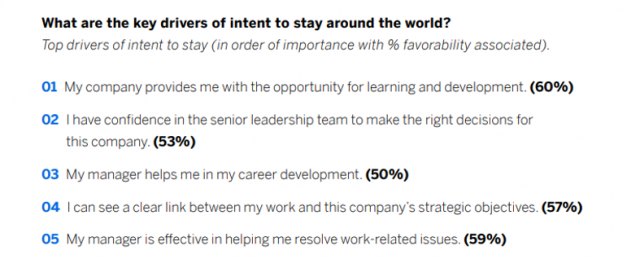Many executives invest in creating the best communication models for talking to partners and customers. But, when you ask them about their internal communication strategies, they’re a lot less informed. Internal communication is the backbone of a successful organization. It’s the key to creating an inclusive and positive work culture, where everyone is engaged and motivated to work towards the company goals. Despite the benefits, it’s common for leaders to fail to understand how a good IC strategy could benefit their organization. As a result, they then under-invest in their IC teams and systems. Let’s take a deeper look at how IC impacts every level of an organization.
Gives Employees a Holistic Company View
Companies want their employees to feel like they belong within the organization. They want them to see their jobs as more than just a means to a paycheck. For workers to relate to your company, they need to understand how it works. Internal communications play a key role here. Transparency is a key aspect of all forms of communication. Organizations need to celebrate their victories, but it’s equally important that they own up to their weaknesses. Employers should be transparent about the data they collect from employees, how that data is used, and any specific rights employees may have over personal data. This transparency is required by many data privacy laws, and it’s also the proper thing to do to promote respect for everyone’s privacy, including employees. It is essential that employers communicate the process to all employees and make sure they understand the regulations and how it affects the company. You can use a privacy policy generator to ensure you’ve created a comprehensive privacy policy that outlines how you handle employee data.
Builds a Positive Workplace Culture
Your work culture is unique to your organization. It is defined by multiple elements such as business beliefs, goals, behaviors, values, work practices, and more. Essentially, work culture refers to the environment in which your employees function. Toxic workplace culture is stressful for employees. It leads to rumors, conflicts, and consequently, reduced productivity. Internal conflicts can derail an employee’s attention from the actual work and cause missed deadlines or poor deliverables. A positive workplace enables your employees to focus on their work and seek improvement opportunities. In a 2020 survey, employees listed their top three reasons for staying with a company.
These reasons were:
- The opportunity for learning and development
- Confidence in the senior leadership team to make the right decisions
- Management helps them in their career development

(Image source)
These are by-products of a positive work culture, where communication has allowed employees, managers, and leaders to work together. You’ll also notice that all 3 of these factors are the results of two-way communication rather than one-way, hierarchical, “managers say it, employees do it” kind of communication.
Promotes Diversity and Inclusion
Diversity and Inclusion (D&I) programs help every employee feel like they are an equal part of the company no matter who they are. Not only do D&I efforts improve work culture, but they also have a positive impact on the bottom line. They boost innovation and help teams gain new perspectives. The Wall Street Journal’s research showed that the 20 most diverse companies had better operating results on average. Their shares generally outperform those of less diverse firms.

(Image source)
D&I programs are becoming prevalent in the workforce, with 63% of millennials saying they would consider quitting if their employer didn’t prioritize diversity and inclusion. All of your D&I initiatives start with a why. If employees don’t understand why inclusion matters and how it impacts the business and workplace, they won’t bother giving their full attention to training programs or policy changes. Having an IC team that can make a case for your D&I by highlighting both business and work culture benefits will help you get employees on board. Let’s say your company has introduced a new organization-wide training program about inclusivity. Every team needs to attend this training program over the next three weeks. In this scenario, your IC team will create newsletters to inform different groups. These newsletters would come along with follow-up emails containing answers to queries, clear instructions, and reminders. They can coordinate schedules so teams don’t miss out on important deadlines. Another great example is if you run a courier service company such as Reliable Couriers. When you offer same-day delivery services or sensitive document delivery, clear communication is fundamental so that customer satisfaction is constantly high and your organization flows like clockwork.
Keeps Your Employees Motivated and Engaged
Good IC measures turn employees into leaders and bring workers, managers, and partners together to work toward organizational goals. It also contributes to efficient HR management 72% of respondents in Gallagher’s 2020 State of the Sector report said that internal communication plays a critical role in capturing and amplifying the employee voice. Internal communication has a hand in three vital employee engagement factors:
- Well-informed workers When everyone within a company knows what they’re working toward, they can understand how their work impacts the organization. Understanding their impact could motivate them to work harder.
- Feedback Feedback helps employees feel like they’re valued. An IC strategy can help companies get feedback from employees and act on them.
- Recognition Recognition plays a crucial role in employee engagement. In a 2020 survey, 90% of workers said receiving recognition motivates them to work harder.
Essentially, you want your employees to feel like they’re a part of a team striving for a common goal, rather than just another cog in the machine. Internal communication helps with this. Innovative IC solutions are needed to keep employees engaged. Just relying on newsletters won’t be enough.
Conclusion
Proving the worth of IC to leadership can be difficult, but it’s made a lot easier when you can show them stats and use cases detailing how communication activities are connected to ROI. It helps improve an organization’s employer branding. Hopefully, this guide is a resource that has helped you do that. Once you’ve proven your worth, it’s time to make a business case for IC to get the tools and resources you need.



